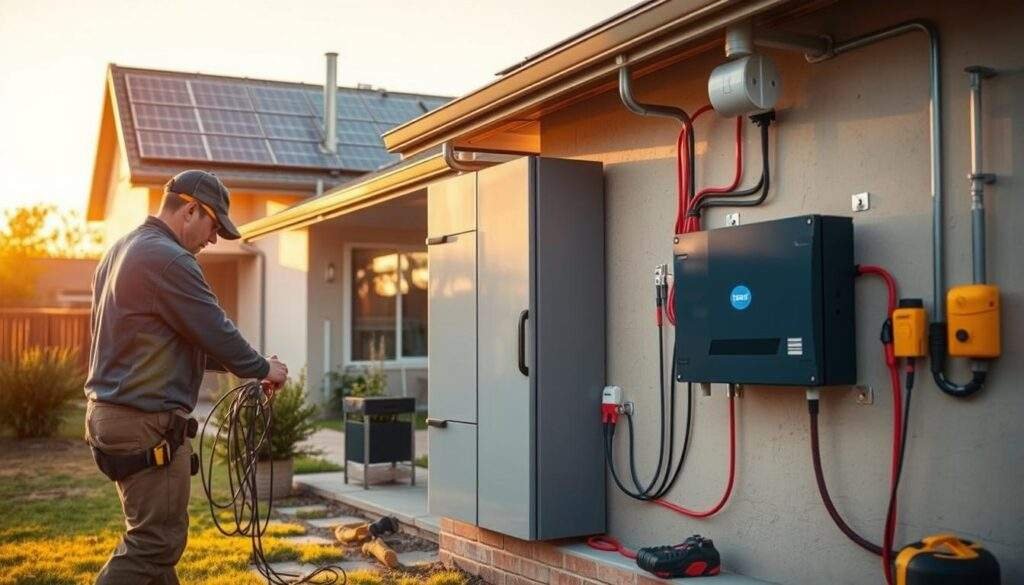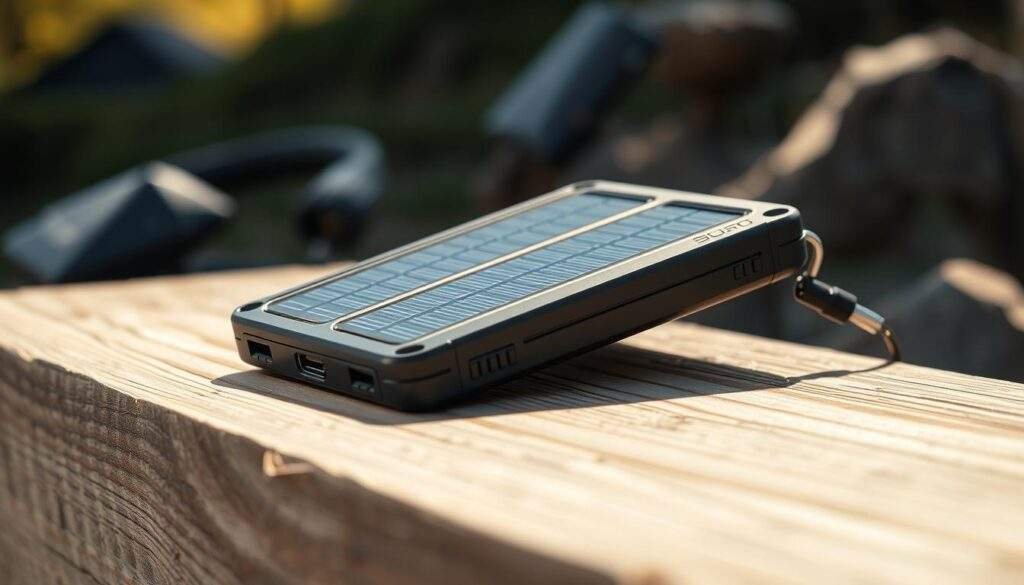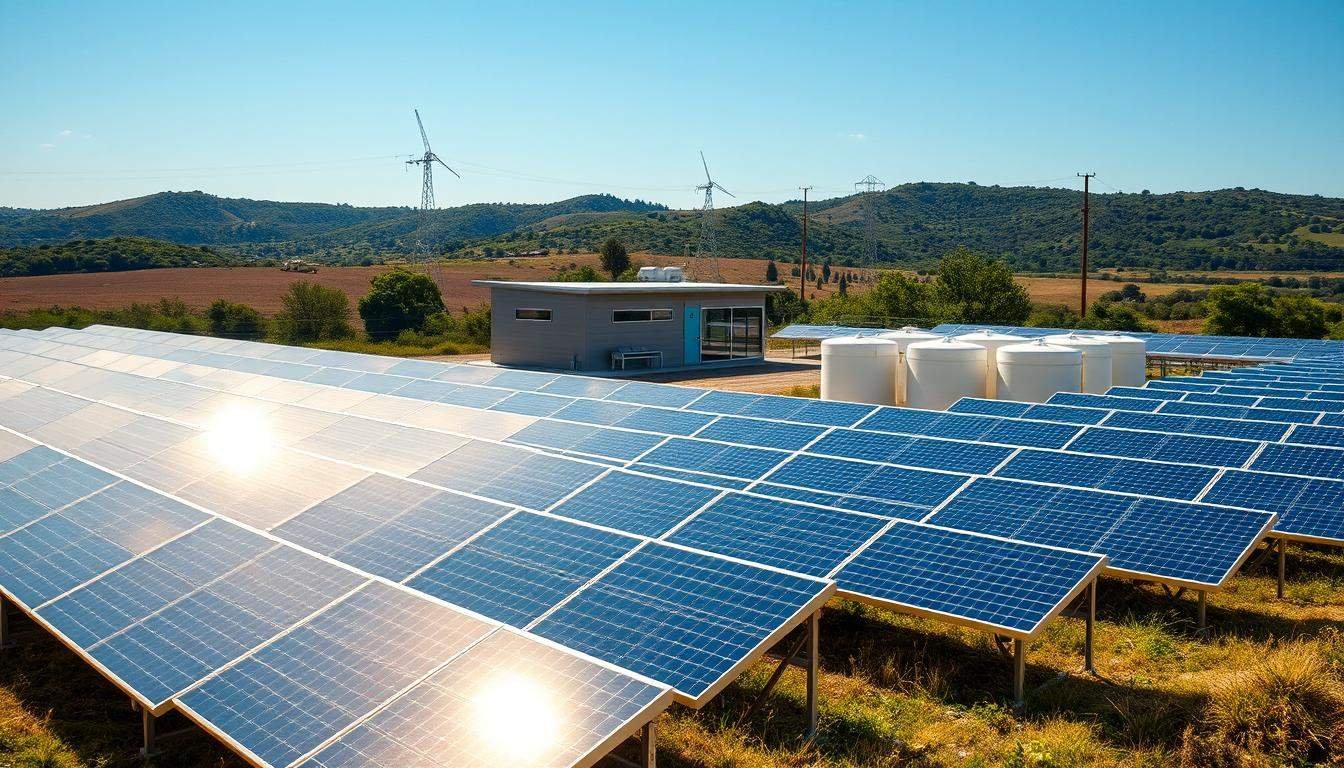Sustainable Solar Battery Solutions: Manufacturing and Recycling
The world is moving towards renewable energy, and you’ll see more solar energy storage needed. The solar industry is expected to create over 27 million tons of waste by 2040. This makes it vital to adopt sustainable practices. Companies like SOLARCYCLE are making old solar panels useful again, cutting down the industry’s environmental impact.
You can join the green movement by choosing sustainable solar battery solutions. These solutions not only cut down on waste but also make renewable energy storage more efficient. As clean energy demand rises, the need for sustainable solar practices grows too.
• Sustainable solar battery solutions are key to reducing waste in the solar industry.
• Companies like SOLARCYCLE are at the forefront of eco-friendly recycling.
Table of contents
- The Evolution of Solar Battery Technology
- Types of Solar Batteries for Home Energy Storage
- How to Assess Your Solar Battery Needs
- The Environmental Impact of Solar Battery Manufacturing
- Sustainable Practices in Solar Battery Production
- Installing Your Solar Battery System: Step-by-Step Guide
- Off-Grid Solar Battery Solutions for Energy Independence
- Maximizing Your Solar Battery Lifespan and Performance
- The Complete Solar Battery Recycling Process
- Portable Solar Battery Options for Outdoor and Emergency Use
- Conclusion: Embracing a Sustainable Energy Future
The Evolution of Solar Battery Technology
The world is moving towards renewable energy, and solar battery tech is key. You might know that more industries need batteries, causing worries about the environment. This has made us think more about how sustainable our choices are.
The Science Behind Energy Storage
Energy storage is vital in solar battery tech. It turns extra energy from solar panels into something we can use later. This magic happens through electrochemistry, where batteries use chemical reactions to store and release energy.
From Lead-Acid to Lithium-Ion: A Brief History
The journey of solar battery tech has seen big steps forward. First, lead-acid batteries were used because they were cheap and easy to find. But, they had downsides like not lasting long or holding much energy.
Then, lithium-ion batteries came along. They changed the game with more energy, lasting longer, and working better.
Current Market Trends in the United States
In the United States, solar battery solutions are in high demand. This is because more people want solar power and to be energy independent. Some trends include:
- More people choosing lithium-ion batteries for homes and businesses
- More need for energy storage that works when the grid goes down
- New battery tech and better recycling methods are showing up
Knowing these trends helps us make better choices about solar battery tech.
Types of Solar Batteries for Home Energy Storage
When looking into solar energy for your home, knowing about solar batteries is key. These batteries help store extra energy from your solar panels for later use. This is a big part of home energy storage systems.
Lithium-Ion Solar Batteries: Pros and Cons
Lithium-ion batteries are popular for home energy storage. They are very efficient and last a long time. They allow you to use more of the stored energy. But, they can cost a lot and need special care.
Lead-Acid Options: When They Make Sense
Lead-acid batteries are another choice for storing energy at home. They are cheaper upfront but less efficient and shorter-lived than lithium-ion batteries. They are good for those with smaller energy needs or a tighter budget.
Flow Batteries and Emerging Technologies
Flow batteries, or vanadium redox batteries, are a new option for long-term energy storage. They can be scaled up for bigger energy needs and last a long time. New technologies like sodium-ion batteries are also being explored.
Comparative Lifespan and Efficiency
When picking a solar battery, think about how long it lasts and how efficient it is. Lithium-ion batteries usually last 10 to 15 years. Lead-acid batteries need to be replaced every 5 to 7 years. Flow batteries can last up to 20 years or more.
How to Assess Your Solar Battery Needs
To find the perfect solar battery system for your home, you must first understand your energy needs. Look at how much energy you use now and what you might need in the future.
Calculating Your Home’s Energy Requirements
Begin by checking your past electricity bills to see your average daily energy use. Energy auditing tools can also help break down your usage. Think about your home’s size, how many people live there, and your energy-saving appliances.
Determining Backup Power Duration
Figure out how long you want your solar battery system to keep power during an outage. This depends on where you live, how often power goes out, and what you prefer. A longer backup time means you’ll need a bigger battery bank.
Scaling Your System for Future Expansion
It’s smart to think about your future energy needs. If you plan to add more solar panels or use more energy, your battery system should grow with you. Look for modular systems that make it easy to add more batteries later.
Tools and Resources for Energy Auditing
Use online tools and talk to experts to get a clear picture of your energy needs. Some utility companies even offer energy audits.
By carefully looking at your solar battery needs, you can make sure your home energy storage system works well and saves you money.
The Environmental Impact of Solar Battery Manufacturing
Making solar batteries is key for green energy, but it faces environmental hurdles. As we seek more renewable energy, knowing the eco-impact of making solar batteries is vital.
Material Sourcing and Extraction Challenges
Getting materials like lithium, cobalt, and nickel for solar batteries is tough. Mining can pollute water, soil, and harm people in some places.
Energy Consumption During Production
Making solar batteries uses a lot of energy, often from fossil fuels. This adds to greenhouse gases, which lessens the green benefits of solar energy.
Water Usage and Chemical Processes
Water is key, as lots are needed for mining and processing. Also, chemicals in making batteries can harm the environment if not handled right.
Comparing Carbon Footprints Across Battery Types
Different solar batteries have different environmental effects. For example, lithium-ion batteries are efficient but harder on the environment to make. Yet, they last longer and work better, making their overall impact lower.
- Lithium-ion batteries: Higher production impact, lower lifecycle emissions.
- Lead-acid batteries: Lower production impact, higher lifecycle emissions.
- Flow batteries: Emerging technology with potentially lower environmental impact.
To lessen these impacts, the industry is adopting greener ways. This includes recycling, using clean energy in making, and making production more efficient.

Sustainable Practices in Solar Battery Production
Sustainable practices are key in the solar battery production world. As more people want renewable energy, makers must cut their environmental impact.
Efficient Material Sourcing
Getting materials the right way is essential. Companies focus on getting lithium, cobalt, and nickel responsibly. They make sure mining is green and workers are treated fairly.
Renewable Energy in Manufacturing
Using green energy in making products is important too. Factories run on solar or wind power. This cuts down on fossil fuel use and emissions.
Waste Reduction and Circular Economy
Less waste is a big goal. Makers aim for products that can be recycled or reused. This saves resources and cuts down on trash.
Leading the Way
Companies like SOLARCYCLE lead in green practices. They focus on recycling solar panels and getting materials right. Their work shows how growth can be sustainable.
Key sustainable practices include:
- Efficient material sourcing
- Renewable energy in manufacturing
- Waste reduction and circular economy approaches
Installing Your Solar Battery System: Step-by-Step Guide
Getting a solar battery system for your home is a big step towards energy freedom. It involves several key steps to make sure your system works well and safely.
Site Assessment and Preparation
First, you need a detailed site assessment. This checks your home’s energy use, your solar array’s condition, and the best spot for your battery. Proper site assessment is vital for your system’s best performance.
Connecting to Your Solar Array
Linking your solar battery system to your solar panels needs careful planning. This step lets your battery store extra energy from your panels. Always follow the maker’s guide and get help if needed.

Integration with Home Electrical Systems
Connecting your solar battery system to your home’s electrical setup is key. This links it to your home’s power panel, so it can power your home when needed. Proper integration ensures your system works safely and efficiently.
Safety Protocols and Permitting Requirements
Always follow safety rules and get the right permits when installing your solar battery system. This means hiring a qualified pro and making sure it meets local codes. Safety is always first with electrical work.
By following these steps and thinking about your home’s needs, you can get a solar battery system that works well. It will give you reliable backup power and boost your energy independence.
Off-Grid Solar Battery Solutions for Energy Independence
Living in remote areas? Off-grid solar battery solutions can make you energy independent. These systems work well where the regular power grid doesn’t reach or is not reliable.
Designing a Self-Sufficient Power System
To create a self-sufficient power system, first figure out your energy needs. Then, decide on the right size and setup for your off-grid solar battery system. You need to know how much energy you use daily and how much sunlight you get.
Key considerations include:
- Energy requirements
- Solar panel efficiency
- Battery storage capacity
- System monitoring and control
Creating a Reliable Solar Battery Bank
A good solar battery bank stores extra energy from your solar panels for nighttime or cloudy days. Lithium-ion batteries are top choices for off-grid systems because they’re efficient and last long.
Backup Generators and Hybrid Systems
Backup generators and hybrid systems boost your off-grid solar battery system’s reliability. They give extra power when sunlight is low or energy needs are high.
Real-World Case Studies of Off-Grid Success
Many examples show off-grid solar battery solutions work well. For instance, a remote cabin in Alaska powered all its needs with an off-grid solar system. It achieved complete energy independence.
These stories show how off-grid solar battery solutions can change energy access and reliability in remote and underserved places.
Maximizing Your Solar Battery Lifespan and Performance
To get the most out of your solar battery system, you need to focus on a few key areas. Keeping it well-maintained and used correctly is essential. This ensures your system works well and lasts a long time.
Optimal Charging and Discharging Practices
How you charge and discharge your solar battery is very important. Try to avoid letting it get too low. Keeping it between 20% and 80% charged is best.
Staying away from extreme charge levels is also good for your battery. Modern solar batteries work best within certain charge and discharge ranges. Knowing these ranges helps your system perform better.
Temperature Management Strategies
Temperature affects how well your solar battery works and how long it lasts. High heat can make it wear out faster, while cold can make it less efficient. Using temperature management strategies like shading or cooling can help keep it at the right temperature.
Monitoring Systems and Performance Tracking
Using monitoring systems to keep an eye on your solar battery’s performance is important. These systems give you live updates on charge, voltage, and temperature. This lets you catch and fix any problems quickly.
Seasonal Maintenance Checklist
- Check the battery’s state of charge and voltage regularly.
- Inspect the system for any signs of wear or damage.
- Ensure that the temperature management systems are functioning correctly.
- Update your monitoring system software to the latest version.
By sticking to these tips and keeping up with maintenance, you can make your solar battery system last longer and work better.
The Complete Solar Battery Recycling Process
Solar battery recycling is key for sustainable renewable energy. As solar energy needs grow, so does the need for green recycling. This ensures we can keep using solar batteries without harming the environment.
Collection Networks and Drop-Off Options
The first step is collecting used batteries. Many places now offer ways to return old batteries. You can find local centers or stores that accept solar batteries for recycling.
Material Recovery and Reprocessing Methods
After collection, batteries are broken down for recycling. New tech can get materials like lithium and nickel back from old batteries. Companies like SOLARCYCLE lead in this, aiming to recycle up to 95% of solar panels and batteries.
Second-Life Applications for Used Batteries
Used solar batteries can get a new job before recycling. They can store energy for less urgent uses. This way, batteries last longer and recycling is delayed.
The Economics of Battery Recycling
The cost of recycling batteries includes collection and processing. But selling the recovered materials can make it profitable. As recycling gets better and bigger, it will become more cost-effective. This makes recycling a better choice for the solar industry.
Portable Solar Battery Options for Outdoor and Emergency Use
When you’re outdoors, having power is key. Portable solar batteries are a green way to keep your devices charged. They’re great for camping, RVing, or emergency prep.

Compact Solar Chargers for Devices
Compact solar chargers are ideal for backpackers and travelers. They’re light, easy to carry, and charge devices on the move. Anker and Goal Zero make top-notch ones with different power levels.
Mid-Size Solutions for Camping and RVs
For camping and RVing, mid-size solar batteries offer more power. They can charge bigger devices and are perfect for longer trips. Think about weight, capacity, and durability when picking one.
Emergency Backup Systems for Critical Needs
In emergencies, a reliable power source is essential. Portable solar batteries can power important devices. This keeps you connected and safe.
Comparing Weight, Capacity, and Durability
- Weight: Lighter ones are easier to carry but might have less power.
- Capacity: It’s measured in watt-hours (Wh). It shows how much power you can store.
- Durability: Choose ones with tough designs and weather-resistant materials.
By looking at these points, you can pick the right portable solar battery. This ensures you’re always ready with power.
Conclusion: Embracing a Sustainable Energy Future
Investing in a solar energy storage system is a big step towards a green future. Solar batteries are key in storing renewable energy. They help you use solar power effectively.
Choosing sustainable options in the solar industry helps our planet. It also cuts down on carbon emissions. Solar batteries will become even more important as we move to clean energy.
A solar battery is not just a gadget. It’s a vital part of your system, giving you energy freedom and dependability. By picking the right solar battery and keeping it in good shape, you’re on your way to a sustainable future.
The need for renewable energy storage is growing fast. This shows how important green energy solutions are. You can join this shift by making smart choices about your solar needs.





One Comment